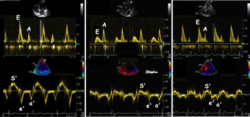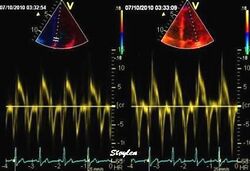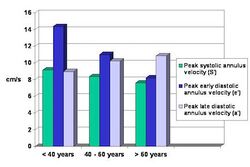Medicine:Tissue Doppler echocardiography
| Tissue Doppler echocardiography | |
|---|---|
| Medical diagnostics | |
| Purpose | measures the velocity of heart muscle |
Tissue Doppler echocardiography (TDE) is a medical ultrasound technology, specifically a form of echocardiography that measures the velocity of the heart muscle (myocardium) through the phases of one or more heartbeats by the Doppler effect (frequency shift) of the reflected ultrasound. The technique is the same as for flow Doppler echocardiography measuring flow velocities. Tissue signals, however, have higher amplitude and lower velocities, and the signals are extracted by using different filter and gain settings. The terms tissue Doppler imaging (TDI) and tissue velocity imaging (TVI) are usually synonymous with TDE because echocardiography is the main use of tissue Doppler.
Like Doppler flow, tissue Doppler can be acquired both by spectral analysis (spectral density estimation) as pulsed Doppler[1] and by the autocorrelation technique as colour tissue Doppler[2] (duplex ultrasonography). While pulsed Doppler only acquires the velocity at one point at a time, colour Doppler can acquire simultaneous pixel velocity values across the whole imaging field. Pulsed Doppler on the other hand, is more robust against noise, as peak values are measured on top of the spectrum, and are unaffected of the presence of clutter (stationary reverberation noise).
Pulsed tissue Doppler echocardiography
This has become a major echocardiographic tool for assessment of both systolic and diastolic ventricular function. However, as this is a spectral technique, it is important to realise that measurement of peak values is dependent on the width of the spectrum, which again is a function of gain setting.[citation needed]
Clinical use
Pulsed wave spectral tissue Doppler has become a universal tool that is part of the general echocardiographic examination. Like any other echocardiographic measurement, measures by tissue Doppler should be interpreted in the context of the whole examination. The velocity curves are in general taken from the base of the mitral annulus at the insertion of the mitral leaflets, in the septal and lateral points of the four chamber view, and eventually the anterior and inferior points of the two-chamber views. For the right ventricle it is customary to use the lateral point of the tricuspid annulus only. Averaging peak velocities from the septal and lateral point has become common, although it has been shown that averaging all four points mentioned above, gives significantly less variability[3]
The method measures annular velocities to and from the probe during the heart cycle.

Annular velocities summarize the longitudinal contraction of the ventricle during systole, and elongation during diastole. Peak velocities are commonly used.[citation needed]
Systolic function
Peak systolic annular velocity (S') of the left ventricle is as close to a contractility measure as you can get by imaging[4] (bearing in mind that any imaging method only measures the result of fibre shortening, without measuring myocyte tension). S' has become a reliable measure of global function[5][6][7][8] It shares the advantage of annular displacement, that it is reduced also in hypertrophic hearts with small ventricles and normal ejection fraction (HFNEF), which is often seen in Hypertensive heart disease, Hypertrophic cardiomyopathy and Aortic stenosis.[9]
Likewise, peak tricuspid annular systolic velocity has become a measure of the right ventricular systolic function[10][11]
Diastolic function
As the ventricle relaxes, the annulus moves towards the base of the heart, signifying the volume expansion of the ventricle. The peak mitral annular velocity during early filling, e' is a measure of left ventricular diastolic function, and has been shown to be relatively independent of left ventricular filling pressure.[12][13][14] If there is impaired relaxation (Diastolic dysfunction), the e' velocity decreases. After the early relaxation, the ventricular myocardium is passive, the late velocity peak a' is a function of atrial contraction. The ratio between e' and a' is also a measure of diastolic function, in addition to the absolute values.[citation needed]
During the two filling phases, there is early (E) and late (A) blood flow from the atrium to the ventricle, corresponding to the annular velocity phases. The flow, is driven by the pressure difference between atrium and ventricle, this pressure difference is both a function of the pressure drop during early relaxation and the initial atrial pressure. In light diastolic dysfunction, the peak early mitral flow velocity E is reduced in proportion to the e', but if relaxation is so reduced that it causes increase in atrial pressure, E will increase again, while e', being less load dependent, remains low. Thus, the ratio E/e' is related to the atrial pressure, and can show increased filling pressure[15][16] although with several reservations.[17][18] In the right ventricle this is not an important principle, as the right atrial pressure is the same as central venous pressure which can easily be assessed from venous congestion.[19][20]

Heart failure with preserved ejection fraction (HFPEF)
One of the main advantages of tissue Doppler is that diastolic and systolic function can be measured by the same tool. Before the advent of tissue Doppler, systolic function was usually assessed with ejection fraction (EF), and diastolic function by mitral flow. This led to the concept of pure "diastolic heart failure". However, In hypertrophic left ventricles with small cavity size, the systolic function is reduced although EF is not, as the EF is dependent on the relative wall thickness.[21] This has led to the concept of "pure diastolic heart failure" being discarded.[9] The preferred term is now heart failure with normal ejection fraction (HFNEF) or heart failure with preserved ejection fraction (HFPEF). This is common and is often seen in hypertensive heart disease, hypertrophic cardiomyopathy and aortic stenosis, and may comprise as much as 50% of the total heart failure population.[22] The prognosis of HFPEF is the same as for heart failure with dilated hearts.[23]
Mitral valve prolapse (MVP)
Pulsed-wave tissue Doppler can be used as a way to evaluate the severeness of arrhythmic mitral valve prolapse, by looking at the peak in the middle of the systole, which looks similar to Prussian Pickelhaube helmet, hence the name Pickelhaube spike.[24] This is one of the risk markers for malignant arrhythmias in patients with myxomatous mitral valve disease (MMVD) and bileaflet mitral valve prolapse (BMVP). It's significant when exceeds 16 cm/s. The sudden systolic overload of which Pickelhaube spike is an expression can act as a trigger for the onset of ventricular arrhythmias.[25]
Normal values and physiology
Normal gender and age related reference values For both S', e' and a' have been established in the large HUNT study, comprising 1266 subjects free of heart disease, hypertension and diabetes.[26]
This study also shows that both S' and e' values decline with age, while a' increases (fig). There is also a significant correlation between S' and e', also in healthy subjects, showing the connection between systolic and diastolic function.[citation needed]
The e'/a' ratio becomes <1 about 60 years of age, which is similar to the E/A ratio of mitral flow. Women has slightly higher S' and e' velocities than men, although the difference disappears with age. The study also did show that velocities were highest in the lateral wall, and lowest in the septum. The E/e' was thus dependent on the site of e' measurement. The ratio was also age dependent.[citation needed]
Colour tissue Doppler
Unlike spectral Doppler, colour tissue Doppler samples velocities from all points of the sector, by shooting two pulses successively, and calculating the velocity from the phase shift between them by autocorrelation. The calculation is slightly different from the true Doppler effect, but the result becomes identical. This results in a single velocity value per sample volume. The result is a velocity field of (nearly) simultaneous velocity vectors towards the probe. The advantage of colour Doppler over spectral Doppler is that all velocities can be sampled simultaneously. The disadvantage is that if there is clutter noise (stationary reverberations), the stationary echoes will be integrated in the velocity calculation, resulting in an under estimate. As pulsed wave Doppler are displayed as a spectrum, the colour Doppler values will correspond to the mean of the spectrum (in the absence of clutter), giving slightly lower values. In the HUNT study, the difference in peak systolic values were about 1.5 cm/s.[26]
The local velocities are not the result of the local function, as segments are moved by the action of neighbouring segments. Thus the velocity differences velocity gradient are the main measure of regional contraction, and has become the most important employment of colour tissue Doppler, in the method of strain rate imaging.[27]
References
- ↑ "Doppler echocardiographic measurement of low velocity motion of the left ventricular posterior wall". The American Journal of Cardiology 64 (1): 66–75. July 1989. doi:10.1016/0002-9149(89)90655-3. PMID 2741815.
- ↑ "Colour Doppler velocity imaging of the myocardium". Ultrasound in Medicine & Biology 18 (6–7): 651–4. 1992. doi:10.1016/0301-5629(92)90080-t. PMID 1413277.
- ↑ "Reproducibility in echocardiographic assessment of the left ventricular global and regional function, the HUNT study". European Journal of Echocardiography 11 (2): 149–56. March 2010. doi:10.1093/ejechocard/jep188. PMID 19959533.
- ↑ "Peak systolic velocity indices are more sensitive than end-systolic indices in detecting contraction changes assessed by echocardiography in young healthy humans". European Journal of Echocardiography 12 (12): 924–30. December 2011. doi:10.1093/ejechocard/jer178. PMID 21940728.
- ↑ "Mitral annular descent velocity by tissue Doppler echocardiography as an index of global left ventricular function". The American Journal of Cardiology 77 (11): 979–84. May 1996. doi:10.1016/s0002-9149(96)00033-1. PMID 8644649.
- ↑ "Assessment of left ventricular long axis contraction can detect early myocardial dysfunction in asymptomatic patients with severe aortic regurgitation". Heart (British Cardiac Society) 85 (1): 30–6. January 2001. doi:10.1136/heart.85.1.30. PMID 11119457.
- ↑ "Differentiation between pathologic and physiologic left ventricular hypertrophy by tissue Doppler assessment of long-axis function in patients with hypertrophic cardiomyopathy or systemic hypertension and in athletes". The American Journal of Cardiology 88 (1): 53–8. July 2001. doi:10.1016/s0002-9149(01)01585-5. PMID 11423058.
- ↑ "Systolic long axis function of the left ventricle. Global and regional information". Scandinavian Cardiovascular Journal 37 (5): 253–8. September 2003. doi:10.1080/14017430310015000. PMID 14534065.
- ↑ 9.0 9.1 "Left ventricular long axis function in diastolic heart failure is reduced in both diastole and systole: time for a redefinition?". Heart (British Cardiac Society) 87 (2): 121–5. February 2002. doi:10.1136/heart.87.2.121. PMID 11796546.
- ↑ "Characteristics of mitral and tricuspid annular velocities determined by pulsed wave Doppler tissue imaging in healthy subjects". Journal of the American Society of Echocardiography 12 (8): 618–28. August 1999. doi:10.1053/je.1999.v12.a99246. PMID 10441217.
- ↑ "Pulsed Doppler tissue imaging of the velocity of tricuspid annular systolic motion; a new, rapid, and non-invasive method of evaluating right ventricular systolic function". European Heart Journal 22 (4): 340–8. February 2001. doi:10.1053/euhj.2000.2296. PMID 11161953.
- ↑ "Assessment of mitral annular dynamics during diastole by Doppler tissue imaging: comparison with mitral Doppler inflow in subjects without heart disease and in patients with left ventricular hypertrophy". American Heart Journal 131 (5): 982–7. May 1996. doi:10.1016/s0002-8703(96)90183-0. PMID 8615320.
- ↑ "Assessment of mitral annulus velocity by Doppler tissue imaging in the evaluation of left ventricular diastolic function". Journal of the American College of Cardiology 30 (2): 474–80. August 1997. doi:10.1016/s0735-1097(97)88335-0. PMID 9247521.
- ↑ "Effects of the reduction of preload on left and right ventricular myocardial velocities analyzed by Doppler tissue echocardiography in healthy subjects". European Journal of Echocardiography 5 (4): 262–71. August 2004. doi:10.1016/j.euje.2003.10.001. PMID 15219541.
- ↑ "Doppler tissue imaging: a noninvasive technique for evaluation of left ventricular relaxation and estimation of filling pressures". Journal of the American College of Cardiology 30 (6): 1527–33. November 1997. doi:10.1016/s0735-1097(97)00344-6. PMID 9362412.
- ↑ "Assessment of diastolic function by tissue Doppler echocardiography: comparison with standard transmitral and pulmonary venous flow". Journal of the American Society of Echocardiography 12 (8): 609–17. August 1999. doi:10.1053/je.1999.v12.a99249. PMID 10441216.
- ↑ "Tissue Doppler imaging in the estimation of intracardiac filling pressure in decompensated patients with advanced systolic heart failure". Circulation 119 (1): 62–70. January 2009. doi:10.1161/CIRCULATIONAHA.108.779223. PMID 19075104.
- ↑ "Use and Limitations of E/e' to Assess Left Ventricular Filling Pressure by Echocardiography". Journal of Cardiovascular Ultrasound 19 (4): 169–73. December 2011. doi:10.4250/jcu.2011.19.4.169. PMID 22259658.
- ↑ "Noninvasive estimation of systolic pressure in the right ventricle in patients with tricuspid regurgitation". European Heart Journal 7 (8): 704–10. August 1986. doi:10.1093/oxfordjournals.eurheartj.a062126. PMID 2945720.
- ↑ "Assessment of right atrial pressure with 2-dimensional and Doppler echocardiography: a simultaneous catheterization and echocardiographic study". Mayo Clinic Proceedings 75 (1): 24–9. January 2000. doi:10.4065/75.1.24. PMID 10630753.
- ↑ "A new method for quantification of left ventricular systolic function using a corrected ejection fraction". European Journal of Echocardiography 12 (3): 228–34. March 2011. doi:10.1093/ejechocard/jeq185. PMID 21216767.
- ↑ "Heart failure with preserved left ventricular systolic function; epidemiology, clinical characteristics, and prognosis". Journal of the American College of Cardiology 43 (3): 317–27. February 2004. doi:10.1016/j.jacc.2003.07.046. PMID 15013109.
- ↑ "One-year mortality among unselected outpatients with heart failure". European Heart Journal 23 (23): 1861–6. December 2002. doi:10.1053/euhj.2002.3282. PMID 12445535.
- ↑ "Pickelhaube Spike, a High-Risk Marker for Bileaflet Myxomatous Mitral Valve Prolapse: Sonographer's Quest for the Highest Spike" (in English). Journal of the American Society of Echocardiography 33 (5): 639–640. May 2020. doi:10.1016/j.echo.2020.02.004. PMID 32199779.
- ↑ "Mitral valve prolapse with ventricular arrhythmias: does it carries a worse prognosis?". European Heart Journal Supplements 23 (Suppl E): E77–E82. October 2021. doi:10.1093/eurheartj/suab096. PMID 34650360.
- ↑ 26.0 26.1 "Reference values and distribution of conventional echocardiographic Doppler measures and longitudinal tissue Doppler velocities in a population free from cardiovascular disease". Circulation: Cardiovascular Imaging 3 (5): 614–22. September 2010. doi:10.1161/CIRCIMAGING.109.926022. PMID 20581050.
- ↑ "Real-time strain rate imaging of the left ventricle by ultrasound". Journal of the American Society of Echocardiography 11 (11): 1013–9. November 1998. doi:10.1016/s0894-7317(98)70151-8. PMID 9812093.
Further reading
- Doppler Myocardial Imaging: A Textbook (1st ed.). Hasselt, Belgium: BSWK. 2006. ISBN 978-90-810592-1-3.
- Myocardial Imaging: Tissue Doppler and Speckle Tracking. Malden, Mass.: Wiley-Blackwell. 2007. ISBN 978-1-4051-6113-8.
 |




